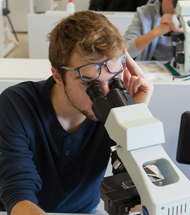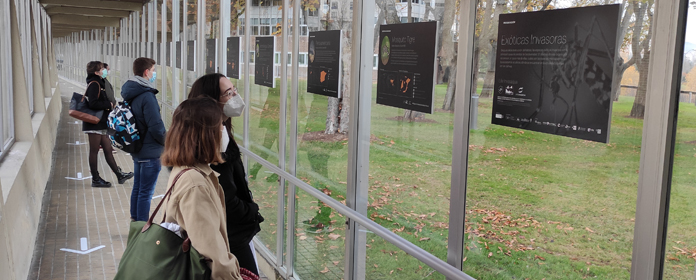More than 1,000 students dive into science at the University of Navarra
The Science and Technology Week has offered lectures, experiment workshops and guided tours to the Museum of Natural Sciences and the CIMA

PHOTO: Manuel Castells
The Science Week has been Closed at the University of Navarra with the participation of the schools IES Sangüesa, Teresianas, Ikastola Paz de Ziganda, IES Alatiz de Barañain and IES Torre Basoco, whose students have participated in the workshops of Physics, Biology, Chemistry and Microbiology and have attended the last lecture, which has been awarded to the professor of Genetics and popularizer Francisco Javier Novo.
Under the degree scroll "The Impossible Planet of the Apes", Novo tried to explain to the students why the plot of this movie is pure science fiction. To do so, he went back in the line of evolution to 6 million years ago, when hominids and chimpanzees separated their evolutionary lines, giving rise to different species that have led to the current man and chimpanzee: "In reality, our 6 million years of evolution and theirs separate us from the chimpanzees: 12 million years for which we can affirm that a current chimpanzee will never evolve to become a human".
"It is true," the expert acknowledged, "that we share some characteristics resulting from this common evolutionary history, such as the concepts of justice, cooperation and sharing, or empathy, mourning and consolation, which are perfectly observed in some primates".
But why will a chimpanzee "never" be an adolescent?The expert -last of the five speakers of the Science Week 2017 at the University of Navarra- also reviewed the major milestones that have marked the evolution of the hominid genus until the appearance of Cro-Magnon man, or modern Homo sapiens: "Although we still do not know in detail what has happened to our species over these 6 million years, it does seem clear that different branches appeared, that several of them lived at the same time and that only one was so successful that it lasts until today. In fact, the last branch to disappear was that of Neanderthal Man, some 30,000 years ago".
According to Novo, a critical milestone in the development of the genus homo was bipedalism (walking upright): "The oldest remains of a bipedal hominid, Lucy, come from 3.6 million years ago. Among its consequences is the change of the Anatomy of the pelvis, which became narrower and caused newborns to have a maximum skull size to make childbirth possible, so that their brain had to grow long after birth (the brain of a newborn occupies about 350 cubic centimeters and reaches 1,350 liters of Issue in an adult) during the stages of childhood and adolescence, which for this reason are necessary and essential in our species," concluded the professor.
More than 900 students from 22 schools participated in this edition of Science Week, attending workshops and conferences organized by the School of Sciences of the University of Navarra; and visited the Museum of Natural Sciences and the research center Applied Medicine (CIMA). Also, in the context of this Week, last Saturday took place the workshop of Open Doors and Experimentation, which was attended by 120 participants from La Rioja, Navarra, Basque Country, Castilla León, Aragón, Santa Cruz de Tenerife, Madrid and Ecuador.





